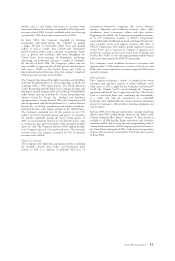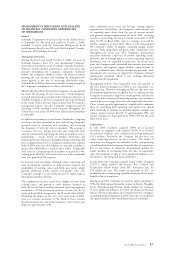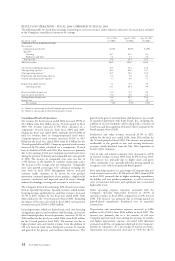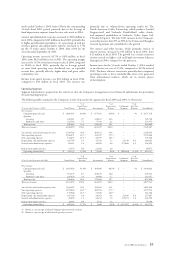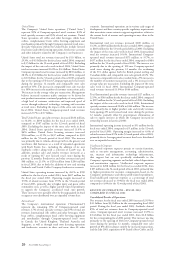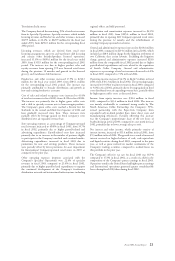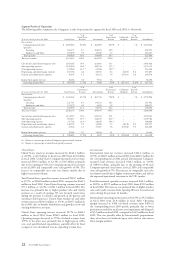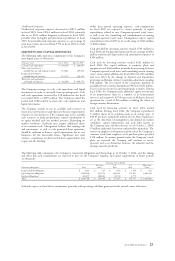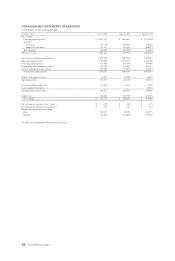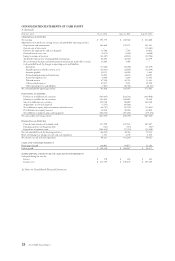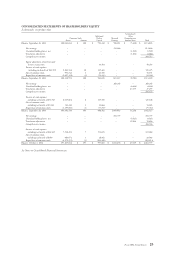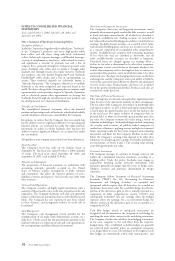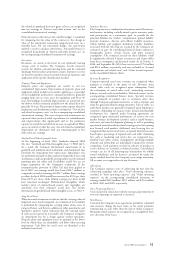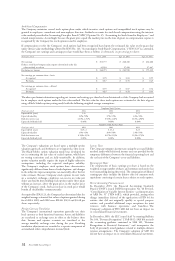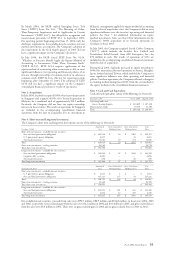Starbucks 2004 Annual Report Download - page 14
Download and view the complete annual report
Please find page 14 of the 2004 Starbucks annual report below. You can navigate through the pages in the report by either clicking on the pages listed below, or by using the keyword search tool below to find specific information within the annual report.Fiscal 2004 Annual Report 25
“General and administrative expenses” on the accompanying
consolidated statements of earnings.
Interest Rate Risk
The Company’s diversifi ed available-for-sale portfolios consist
mainly of fi xed income instruments. The primary objectives of
these investments are to preserve capital and liquidity. Available-
for-sale securities are investment grade and are recorded on
the balance sheet at fair value with unrealized gains and losses
reported as a separate component of “Accumulated other
comprehensive income/(loss).” The Company does not hedge
its interest rate exposure. The Company performed a sensitivity
analysis based on a 10% change in the underlying interest rate
of its interest bearing fi nancial instruments held at the end of
fi scal 2004, and determined that such a change would not have a
material effect on the fair value of these instruments.
SEASONALITY AND QUARTERLY RESULTS
The Company’s business is subject to seasonal fl uctuations.
Signifi cant portions of the Company’s net revenues and profi ts
are realized during the fi rst quarter of the Company’s fi scal
year, which includes the December holiday season. In addition,
quarterly results are affected by the timing of the opening of
new stores, and the Company’s rapid growth may conceal the
impact of other seasonal infl uences. Because of the seasonality
of the Company’s business, results for any quarter are not
necessarily indicative of the results that may be achieved for
the full fi scal year.
APPLICATION OF CRITICAL
ACCOUNTING POLICIES
Critical accounting policies are those that management believes
are both most important to the portrayal of the Company’s
fi nancial condition and results, and require management’s most
diffi cult, subjective or complex judgments, often as a result of
the need to make estimates about the effect of matters that are
inherently uncertain. Judgments and uncertainties affecting the
application of those policies may result in materially different
amounts being reported under different conditions or using
different assumptions.
Starbucks considers its policies on impairment of long-lived
assets to be most critical in understanding the judgments that are
involved in preparing its consolidated fi nancial statements.
Impairment of Long-Lived Assets
When facts and circumstances indicate that the carrying
values of long-lived assets may be impaired, an evaluation of
recoverability is performed by comparing the carrying values of
the assets to projected future cash fl ows, in addition to other
quantitative and qualitative analyses. For goodwill and other
intangible assets, impairment tests are performed annually and
more frequently if facts and circumstances indicate goodwill
carrying values exceed estimated reporting unit fair values
and if indefi nite useful lives are no longer appropriate for the
Company’s trademarks. Upon indication that the carrying
values of such assets may not be recoverable, the Company
recognizes an impairment loss as a charge against current
operations. Property, plant and equipment assets are grouped at
the lowest level for which there are identifi able cash fl ows when
assessing impairment. Cash fl ows for retail assets are identifi ed at
the individual store level. Long-lived assets to be disposed of are
reported at the lower of their carrying amount or fair value, less
estimated costs to sell. Judgments made by the Company related
to the expected useful lives of long-lived assets and the ability of
the Company to realize undiscounted cash fl ows in excess of the
carrying amounts of such assets are affected by factors such as the
ongoing maintenance and improvements of the assets, changes
in economic conditions and changes in operating performance.
As the Company assesses the ongoing expected cash fl ows and
carrying amounts of its long-lived assets, these factors could
cause the Company to realize material impairment charges.
NEW ACCOUNTING STANDARDS
In December 2003, the Financial Accounting Standards
Board (“FASB”) issued FASB Interpretation No. 46 Revised,
“Consolidation of Variable Interest Entities – an Interpretation
of ARB No. 51” (“FIN 46R”), which provided, among other
things, immediate deferral of the application of FIN 46 for
entities that did not originally qualify as special purpose
entities, and provided additional scope exceptions for joint
ventures with business operations and franchises. The
Company’s adoption of FIN 46R did not have an impact on
its consolidated fi nancial statements.
In December 2003, the SEC issued Staff Accounting
Bulletin No. 104, “Revenue Recognition” (“SAB 104”).
SAB 104 rescinds the accounting guidance contained in
SAB 101, “Revenue Recognition in Financial Statements,” and
incorporates the body of previously issued guidance related
to multiple-element revenue arrangements. The Company’s
adoption of SAB 104 did not have an impact on its consolidated
fi nancial statements.
In March 2004, the FASB ratifi ed Emerging Issues Task
Force (“EITF”) Issue No. 03-1, “The Meaning of Other-
Than-Temporary Impairment and its Application to Certain
Investments” (“EITF 03-1”), but delayed the recognition and
measurement provisions of EITF 03-1 in September 2004.
For reporting periods beginning after June 15, 2004, only the
disclosure requirements for available-for-sale securities and cost
method investments are required. The Company’s adoption of
the requiremens in the fi scal fourth quarter of 2004 did not
have a signifi cant impact on the Company’s disclosures.
In July 2004, the FASB issued EITF Issue No. 02-14,
“Whether an Investor Should Apply the Equity Method of
Accounting to Investments Other Than Common Stock”
(“EITF 02-14”). EITF 02-14 requires application of the
equity method of accounting when an investor is able to
exert signifi cant infl uence over operating and fi nancial
policies of an investee through ownership of common stock
or in-substance common stock. EITF 02-14 is effective for
reporting periods beginning after September 15, 2004. The
adoption of EITF 02-14 will not have a signifi cant impact on
the Company’s consolidated fi nancial position or results of
operations.


